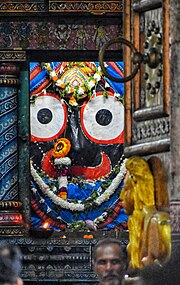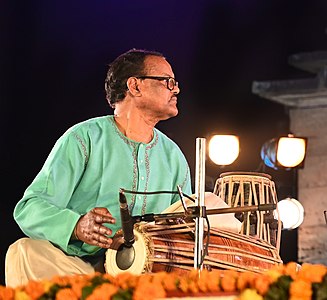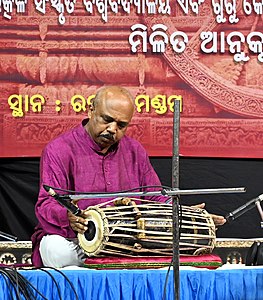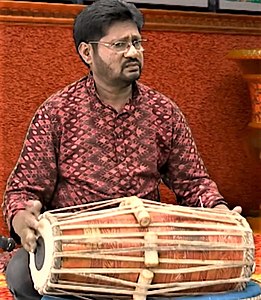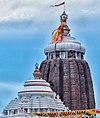
PanditDamodar Hota was an Indian classical vocalist, musicologist, composer, and guru based in Odisha, India. He was an exponent of Hindustani classical music as well as Odissi classical music.

Odissi music is a genre of classical music originating from the eastern state of Odisha. Rooted in the ancient ritual music tradition dedicated to Lord Jagannatha, Odissi music has a rich history spanning over two thousand years, distinguished by its unique sangita-shastras, a specialized system of Ragas and Talas, and a distinctive style of performance characterised by the andolita gamaka. Odissi compositions are largely written in Sanskrit and Odia.
Gangadhar Pradhan was an Indian Odissi dancer.

Mrudanga, also known as Khola is a classical percussive instrument native to the east Indian state of Odisha with a developed distinct traditional repertoire and technique. It has been used alongside the Mardala in Odissi classical music from ancient times, which is a comparatively bass-heavy drum as opposed to the high-pitched Mrudanga.

Gotipua is a traditional dance form in the state of Odisha, India, and the precursor of Odissi classical dance. It has been performed in Orissa for centuries by young boys, who dress as women to praise Jagannath and Krishna. The dance is executed by a group of boys who perform acrobatic figures inspired by the life of Radha and Krishna. The boys begin to learn the dance at an early age until adolescence, when their androgynous appearance changes. In the Odia language, Gotipua means "single boy" (goti-pua). Raghurajpur, Odisha is a historic village known for its Gotipua dance troupes. The dance of the Gotipuas is accompanied by traditional Odissi music with the primary percussion being the Mardala.
Maguni Charan Das was an Indian traditional dancer of Gotipua, a traditional dance form of Odisha.

Prahallada Nataka is a traditional play native to the Indian state of Odisha. It narrates the story of Vishnu's man-lion avatar, Nrusingha or Narasimha, through over 200 songs based on almost 30 ragas of Odissi music. The play is based on a text by Raja Ramakrusna Chhotaraya, King of Jalantara, a small kingdom in former southern Odisha, now in the Srikakulam district of Andhra Pradesh.

Banamali Maharana was an Indian percussionist who played Mardala.

Utkal Sangeet Mahavidyalaya is a performing arts-cum-educational institution in Bhubaneswar, Odisha, India.

PanditGopal Chandra Panda is a Guru of Odissi classical music, vocalist, researcher and composer. A disciple of Singhari Shyamsundar Kar, he has authored several books such as Odissi Raga Ratnabali & Odissi Raga Darpana, and is acclaimed for his efforts to collect & document several traditional Odissi ragas from the hinterlands. Panda served as a lecturer and head of department in the Utkal Sangeet Mahavidyalaya for nearly three decades. He has performed in music festivals across the country and is the founder of the Gopal Panda Odissi Academy. In 2011, Panda received the Sangeet Natak Akademi Award for his contributions to Odissi music.

PanditRamarao Patro is an Odissi music Guru, Odissi Bina exponent or Binākāra, noted composer & vocalist. He has composed music for hundreds of Odissi dance items and has worked closely with the founding Gurus of Odissi dance including Guru Pankaj Charan Das, Guru Deba Prasad Das & Guru Kelucharan Mahapatra. He has widely performed Odissi Bina recitals across the state. He presently teaches Odissi Veena to students at Guru Ramhari Das' Odissi Gurukul at Biragobindapur, Puri, Odisha. Patro is the very last Guru and artiste of the Odissi Veena. Patro started his initial training at the age of six in the Gandhiji Sangita Kalamandira established by Acharya Tarini Charan Patra in his hometown. He initially trained under Guru Bauribandhu Das and Guru Krusna Chandra Brahma. He then learned vocal Odissi music and the intricacies of the Bina in the Odissi style of music from Tarini Charan Patra himself. He later joined the Utkal Sangeet Mahavidyalaya as a student and continued his musical education there. He is the author of a voluminous book 'Odissi Sangita Baridhi' documenting details of 60 Odissi ragas and 140 traditional Odissi compositions as taught by Guru Tarini Charan Patra.

PanditRamhari Das is a leading singer, composer, musicologist and Guru of Odissi music. Known for his renditions, compositions, lecture-demonstrations and writings, Das has served as a professor and led the Odissi vocal department in prominent musical institutions of Odisha, including the Utkal Sangeet Mahavidyalaya and the Utkal University of Culture. He is the founder of Ramhari Das Odissi Gurukula at Biragobindapur, Puri. For his contributions to Odissi music, Das received the Sangeet Natak Akademi award in 2008.

Dhaneswar Swain is an exponent and Guru of the Odissi Mardala, the traditional percussion instrument of Odissi music. He is known for his rhythmic compositions and fingering techniques, as well as his efforts to promote solo Mardala recitals and group presentations combining traditional percussive instruments from Odisha. He founded Vadya Vani Gurukula, an institution for training and research in Odissi Mardala, and other traditional Odisha percussion instruments.

Shyamamani Devi is a Odissi classical music vocalist composer. A disciple of Gurus Singhari Shyamsundar Kar and Balakrushna Dash, she is known for her popular renditions of classical Odissi music, such as Odissi, Chhanda, Champu, etc. authored by medieval Odia musician-poets such as Upendra Bhanja, Kabisurjya Baladeba Ratha, Banamali Dasa, Gopalakrusna and others. She is also known for her renditions of light music such as traditional Odia folk music ,Odia film music and adhunika songs. In 2022, she was awarded the Padma Shri for he contributions to Odissi music.

Desaraja AdiguruSinghari Shyamasundar Kar was a renowned Odissi musician, Guru, singer, scholar and composer. Born to a sebayata (servitor) family of the Jagannatha Temple, he was groomed under veteran masters of the temple tradition and soon rose to be one of the towering Gurus of Odissi classical music in the 20th century. He was most known for his powerful voice and intricate style, his command over the Mardala as well as his contribution towards the academic institutionalization of Odissi music education. Most of the performers of Odissi music, Mardala and Odissi dance of his period admit to having come under the commanding influence and knowledge of Singhari. He died on 16 March 1975.

The Sangita Narayana is a 17th-century musical treatise belonging to the tradition of Odissi music, written by musician Kabiratna Purusottama Misra and attributed to Gajapati Sarbagya Jagannatha Narayana Deva of Paralakhemundi. It is one of the most important musical treatises discovered from Odisha and is one of the fundamental texts followed in Odissi music till date. The treatise was first published by the Odisha Sangeet Natak Akademi in 1966, followed by a critical edition published by the Indira Gandhi National Centre for the Arts in 2009. Manuscripts of the work are found across India, indicating its national circulation. In 1987, Jonathan Katz in his D. Phil. thesis extensively analysed the musicological portions of the Sangitanarayana.
Dhanasri is a rāga belonging to the tradition of Odissi music. Falling under the meḷa of the same name, the raga uses komala gandhara and komala nisada swaras and is traditionally associated with the karuṇa rasa. The raga is mentioned in treatises such as the Gita Prakasa and Sangita Narayana.
Gujjari is a rāga belonging to the tradition of Odissi music. Falling under the meḷa Karnāta, the raga uses komala gandhara, komala dhaibata and komala nisada swaras and is traditionally associated with the karuṇa rasa. The raga is mentioned in treatises such as the Gita Prakasa and Sangita Narayana. Among its angaragas, Mangala Gujjari is most prominent and has been used by Jayadeva in his Gita Govinda, alongside Gujjari itself.
Ramakeri is a rāga belonging to the tradition of Odissi music. Falling under the meḷa Barādi, the raga uses komala rusabha, komala dhaibata and tibra madhyama swaras and is traditionally associated with the karuṇa rasa. The raga is mentioned in treatises such as the Gita Prakasa and Sangita Narayana. This raga has been used by the 12th-century Odia composer Jayadeva in his Gita Govinda.
Baradi is a rāga belonging to the tradition of Odissi music. Falling under the meḷa Barādi, the raga uses komala rusabha, komala dhaibata and tibra madhyama swaras and is traditionally associated with the karuṇa rasa. The raga is mentioned in treatises such as the Gita Prakasa and Sangita Narayana. This raga has been used by the 12th-century Odia composer Jayadeva in his Gita Govinda along with its angaraga Desa Barādi.






